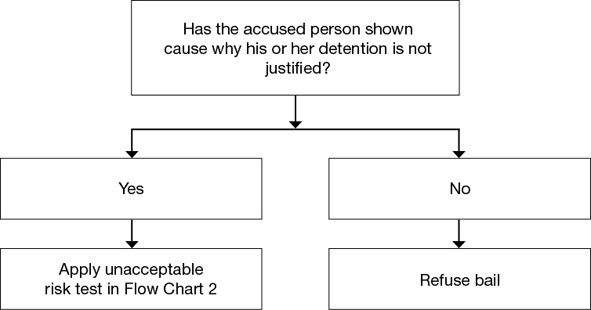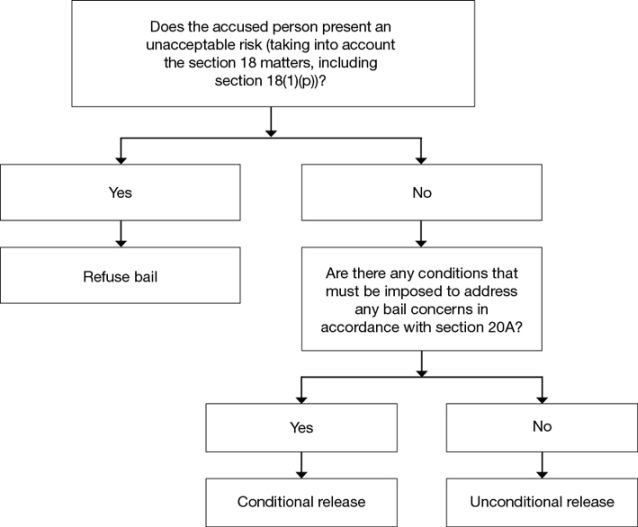Special Bulletin 8 — January 2015
Bail Amendment Act 2014
The Bail Amendment Act 2014 (the amending Act) amends the Bail Act 2013 (the Act). The amending Act has been proclaimed to commence on 28 January 2015: LW 16.01.15. The amending Act applies to offences committed or alleged to have been committed, or charged, before the commencement of the amendment: Sch 3, Pt 3, s 12.
The amending Act essentially gives effect to various recommendations made by John Hatzistergos (prior to his appointment) in an interim report titled Review of the Bail Act (published in July 2014). The amending Act inserts a preamble to the Act and makes a number of other important amendments set out below. Briefly, it requires that bail for certain serious offences be refused unless the accused shows cause why detention is not justified. It also requires the bail authority to consider additional matters in applying the unacceptable risk test. The amending Act inserts new flow charts for the bail decision and special rules for certain offences. Both flow charts are reproduced overleaf.
Show cause requirement
Schedule 1[6] of the amending Act inserts Div 1A “Show cause requirement” into the Act. Section 16A(1) of that Division provides that a bail authority making a bail decision for a show cause offence must refuse bail unless the accused person shows cause why his or her detention is not justified. If the accused person shows cause why his or her detention is not justified, the bail authority must make a bail decision in accordance with Div 2 (Unacceptable risk test — all offences): s 16A(2). Section 16A does not apply if the accused was under 18 years of age at the time of the offence: s 16A(3).
Show cause offences
Offences to which the show cause requirement applies are listed in the new s 16B of the Act. The provision applies to over 900 offences. These include State offences punishable by imprisonment for life; certain sexual offences against child victims; offences “involving” wounding or grievous bodily harm; serious personal violence offences; certain drug, firearm and prohibited weapon offences; serious indictable offences (as defined in s 4 Crimes Act 1900) committed while an accused is on bail or on parole; and an indictable offence, or an offence of failing to comply with a supervision order, committed while the accused is subject to a supervision order. Suffice to state that it will be the task of the bail authority to determine whether the offence or offences in a given case fall within the terms of s 16B.
Unacceptable risk test — all offences
Schedule 1[8] of the amending Act replaces the existing unacceptable risk assessment process (whereby the bail authority first determines whether there is an unacceptable risk in granting bail and then determines whether there are bail conditions that might mitigate that risk). Under the new procedure, the bail authority assesses any bail concerns before making a bail decision (new s 17). The new s 18 sets out the matters a court must consider as part of that assessment including, inter alia, the nature and seriousness of the offence, the accused’s criminal history, and, in s 18(1)(p), the bail conditions that could reasonably be imposed to address any bail concerns.
A bail concern is defined in s 17(2) as a concern that the accused, if released, will fail to appear, commit a serious offence, endanger the safety of victims, individuals or the community, or interfere with witnesses or evidence. A bail authority must refuse bail where “the bail authority is satisfied, on the basis of an assessment of bail concerns … that there is an unacceptable risk”: s 19.
Flow charts
Schedule 1[5] repeals and replaces s 16 of the Act. The new s 16 contains two flow charts. The first sets out how the show cause requirement applies to show cause offences. Flow chart 2 illustrates the process for approaching the unacceptable risk test as it applies to all offences. The flow charts are appended below.
Special rules for certain offences
The current s 22(1) provides that a court is not to grant or dispense with bail where the offence is one for which an appeal is pending in the Court of Criminal Appeal or High Court in relation to a conviction on indictment or a sentence imposed on a conviction on indictment unless special or exceptional circumstances exist justifying that bail decision.
The amending Act inserts s 22(2) to provide that if the offence is a show cause offence, the requirement that the accused establish special or exceptional circumstances under s 22(1) applies instead of the requirement that the accused show cause why his or her detention is not justified.
Schedule 1[19] inserts s 53(4) to clarify that the power of the court to grant bail of its own motion under s 53 does not apply if the offence is a show cause offence.
Other amendments
The Statute Law (Miscellaneous Provisions) Act (No 2) 2014 amends the amending Act by deleting reference to the “Firearms Act 1996” from proposed s 16B(1)(e)(i) in Sch 1[6] and replacing it with “Weapons Prohibition Act 1998”. This provision of the Statute Law (Miscellaneous Provisions) Act (No 2) 2014 commenced on 8 January 2015.
Further material
See also the recent law item for the amending Act on the recent legislation component of JIRS. There are links to the Second Reading Speech and the interim report Review of the Bail Act. The Bail section of the Local Court Bench Book (accessible on JIRS and the Judicial Commission’s website) will reflect the amendments to the Act.

